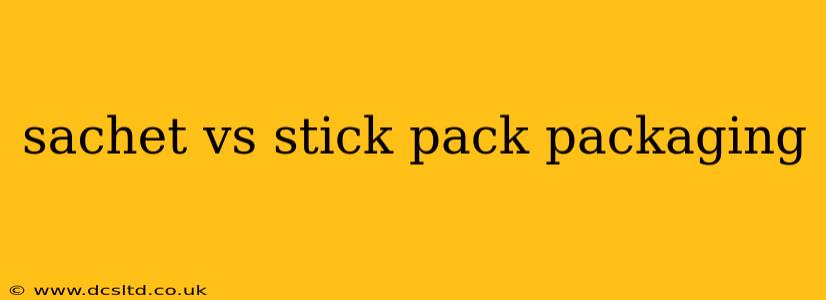Choosing the right packaging for your product is crucial for its success. For single-serve or portion-controlled items, the decision often comes down to sachets and stick packs. While both offer convenience and portability, they have distinct differences that impact functionality, cost, and overall consumer experience. This comprehensive guide will delve into the nuances of sachet vs. stick pack packaging, helping you make an informed decision for your brand.
What is Sachet Packaging?
Sachet packaging refers to small, flexible pouches, typically made of foil, plastic film, or a combination of both. They are sealed on all sides, creating a tamper-evident barrier to protect the product's quality and freshness. Sachets are commonly used for a wide range of products, including condiments, spices, tea, coffee, and personal care items. Their versatility and relatively low cost make them a popular choice across numerous industries.
What is Stick Pack Packaging?
Stick packs, also known as single-serve stick packs or pillow packs, are similar to sachets but possess a unique, elongated shape. They are typically made from flexible materials like laminates or films and are designed for easy dispensing and use. The flat, rectangular format makes them ideal for powders, granules, liquids, and pastes. Stick packs often feature a tear notch for easy opening, enhancing consumer convenience.
Sachet vs. Stick Pack: Key Differences
Here’s a detailed comparison highlighting the key differences between sachet and stick pack packaging:
Shape and Design:
- Sachets: Vary in shape but are generally square or rectangular, sometimes with a slightly curved or pillowed design.
- Stick Packs: Long and narrow, resembling a stick or a small pillow. Their elongated shape facilitates easy pouring or dispensing.
Materials:
- Sachets: Can be made from a variety of materials, including foil, plastic films (e.g., polyethylene, polypropylene), and laminated structures. The choice of material often depends on the product's properties and shelf-life requirements.
- Stick Packs: Commonly utilize flexible laminates that combine different layers for barrier properties, strength, and printability. These laminates often include layers of polyethylene, polypropylene, aluminum foil, and other specialized films.
Filling and Sealing:
- Sachets: Various filling and sealing methods can be employed, ranging from manual to fully automated high-speed systems.
- Stick Packs: Typically filled and sealed using specialized, high-speed machinery designed for their unique shape.
Cost:
- Sachets: Generally less expensive to produce than stick packs, particularly for simpler designs and lower production volumes.
- Stick Packs: Often require more specialized equipment, resulting in higher initial investment costs. However, the high-speed nature of the filling and sealing process can offset this in high-volume production.
Consumer Convenience:
- Sachets: Easy to open, although some may require scissors or a sharp object.
- Stick Packs: Typically feature a tear notch or easy-open design, promoting seamless dispensing without additional tools.
Which Packaging is Better for My Product?
The optimal choice between sachet and stick pack packaging hinges on several factors:
- Product Type: Powders, granules, and some liquids are well-suited to stick packs, while thicker liquids and pastes may be better packaged in sachets.
- Production Volume: High-volume production often favors stick packs due to the efficiency of their filling and sealing processes. Sachets are suitable for both low and high-volume needs.
- Budget: Sachets often offer a more budget-friendly option, especially for smaller businesses.
- Branding and Aesthetics: Both offer opportunities for creative branding and design elements. The elongated format of stick packs can make them particularly eye-catching on shelves.
- Target Audience: Consider your target audience's preferences and demographics when making your decision. Stick packs may appeal to those prioritizing convenience.
Frequently Asked Questions
What are the advantages of using sachet packaging?
Sachet packaging offers several advantages, including low cost, ease of production for a variety of products, and wide material choices to suit specific product needs. Their versatility makes them suitable for various industries and product types.
What are the disadvantages of using sachet packaging?
While cost-effective, sachets might lack the ease of opening offered by stick packs. Some may require scissors, potentially hindering consumer convenience.
What are the advantages of using stick pack packaging?
Stick packs excel in terms of consumer convenience, with easy-open features ensuring mess-free dispensing. Their sleek design is also visually appealing, contributing to attractive shelf presence.
What are the disadvantages of using stick pack packaging?
Stick pack packaging often entails higher initial investment costs due to specialized machinery requirements. The production process may also be less adaptable to low-volume needs than sachet packaging.
Can I use both sachet and stick pack packaging for different product lines?
Absolutely! Many companies utilize both packaging types depending on the specific product and its requirements. This flexibility enables them to cater to diverse consumer preferences and product characteristics.
By carefully considering these factors and weighing the pros and cons of each packaging type, you can select the solution that best aligns with your product, target market, and business objectives. Remember, the right packaging can significantly influence your product's success, contributing to positive consumer experiences and increased brand loyalty.
